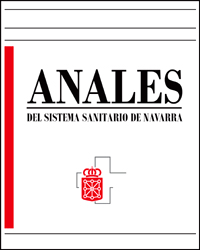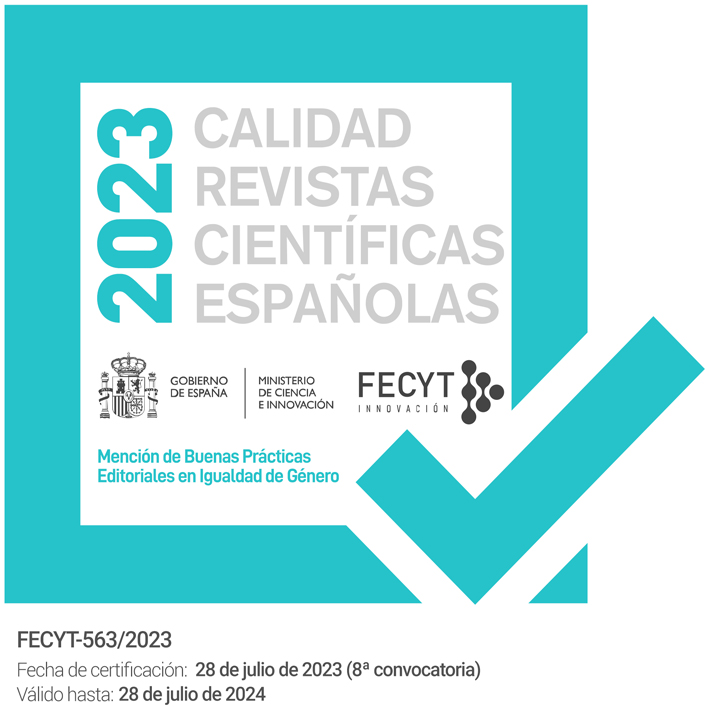Analysis of the characteristics of door-to-door advertising sent by supermarkets in the Principality of Asturias (Spain): a cross-sectional study
DOI:
https://doi.org/10.23938/ASSN.0866Keywords:
Feeding., Alcoholic beverages., Food publicity., Direct-to-Consumer advertising., Public Health.Abstract
Background. To analyze which foods and beverages, frequently included in advertising mail delivered by supermarkets in the Principality of Asturias, can be considered essential for consumption by the population, as well as to compare their price with that of essential products.
Methods. Cross-sectional, descriptive study of supermarket sales circulars delivered to seven homes in Asturias (Spain) by four supermarket chains from July to December 2018. Type of product, its classification as essential or non-essential and mean price of the advertised product were registered.
Results. The study identified 14,314 products, mostly belonging to the categories: “cakes, pastries, chocolate, sugar, and sweeteners” (15.3 %), “milk and milk derivatives” (9.7 %), “processed meats”.and “alcoholic beverages” (8.9 % each) and “ready-made” (8.4 %). Products considered to be non-essential were found to predominate (61.9 %). Significant differences in product type were observed between supermarket chains. Essential products had a lower mean price than the non-essential products, both overall and for each supermarket chain, and was significantly lower for one of them. .
Conclusions. Products which are non-essential from the point of view of health, such as sugar-rich products, processed meats, and alcoholic beverages, dominated the advertising mail delivered door-to-door by supermarkets in the Principality of Asturias. On a positive note, the prices of essential products, such as fresh fruit and vegetables, were, on average, significantly lower than the prices of non-essential products.
Downloads
References
VILARNAU C, STRACKER DM, FUNTIKOV A, DA SILVA R, ESTRUCH R, BACH-FAIG A. Worldwide adherence to Mediterranean Diet between 1960 and 2011. Eur J Clin Nutr 2019; 72: 83-91. https://doi.org/10.1038/s41430-018-0313-9
CHARLTON EL, KÄHKÖNEN LA, SACKS G, CAMERON A.J. Supermarkets and unhealthy food marketing: an international comparison of the content of supermarket catalogues/circulars. Prev Med 2015; 81: 168-173. https://doi.org/10.1016/j.ypmed.2015.08.023
BROTONS CUIXART C, LOBOS BEJARANO JM. New European guidelines for cardiovascular prevention and its Spanish adaptation. Aten Primaria 2017; 49: 201-203. https://doi.org/10.1016/j.aprim.2017.03.002
SERRA-MAJEM L, ROMÁN-VIÑAS B, SANCHEZ-VILLEGAS A, GUASCH-FERRÉ M, CORELLA D, LA VECCHIA C. Benefits of the Mediterranean diet: epidemiological and molecular aspects. Mol Aspects Med 2019; 67: 1-55. https://doi.org/10.1016/j.mam.2019.06.001
ARANCETA BARTRINA J, ARIJA VAL V, MAÍZ ALDALUR E, MARTÍNEZ DE LA VICTORIA MUÑOZ E, ORTEGA ANTA RM, PÉREZ-RODRIGO C et al. Dietary guidelines for the Spanish population (SENC, December 2016); the new graphic icon of healthy nutrition. Nutr Hosp 2016; 33: 1-48. https://doi.org/10.20960/nh.827
Agencia Española de Consumo, Seguridad Alimentaria y Nutrición (AECOSAN). Ministerio de Sanidad, Consumo y Bienestar Social. Gobierno de España. Plan de colaboración para la mejora de la composición de los alimentos y bebidas y otras medidas. http://www.aecosan.msssi.gob.es/AECOSAN/docs/documentos/nutricion/PLAN_COLABORACION_2020.pdf
ACHÓN M, SERRANO M, GARCÍA-GONZÁLEZ Á, ALONSO-APERTE E, VARELA-MOREIRAS G. Present food shopping habits in the Spanish adult population: a cross-sectional study. Nutrients 2017; 9: 5. pii:E508. https://doi.org/10.3390/nu9050508
JAHNS L, SCHEETT AJ, JOHNSON LK, KREBS-SMITH SM, PAYNE CR, WHIGHAM LD et al. Diet quality of items advertised in supermarket sales circulars compared to diets of the US population, as assessed by the Healthy Eating Index-2010. J Acad Nutr Diet 2016; 116: 115-122. https://doi.org/10.1016/j.jand.2015.09.016
MARTIN-BIGGERS J, YORKIN M, ALJALLAD C, CIECIERSKI C, AKHABUE I, MCKINLEY J et al. What foods are US supermarkets promoting? A content analysis of supermarket sales circulars. Appetite 2013; 62: 160-165. https://doi.org/10.1016/j.appet.2012.12.001
RAVENSBERGEN EA, WATERLANDER WE, KROEZE W, STEENHUIS IH. Healthy or Unhealthy on Sale? A cross-sectional study on the proportion of healthy and unhealthy foods promoted through flyer advertising by supermarkets in the Netherlands. BMC Public Health 2015; 15: 470. https://doi.org/10.1186/s12889-015-1748-8
CHAPMAN K, GOLDSBURY D, WATSON W, HAVILL M, WELLARD L, HUGHES C et al. Exploring perceptions and beliefs about the cost of fruit and vegetables and whether they are barriers to higher consumption. Appetite 2017; 113: 310-319. https://doi.org/10.1016/j.appet.2017.02.043
PINHO MGM, MACKENBACH JD, CHARREIRE H, OPPERT JM, BÁRDOS H, GLONTI K et al. Exploring the relationship between perceived barriers to healthy eating and dietary behaviours in European adults. Eur J Nutr 2018; 57: 1761-1770. https://doi.org/10.1007/s00394-017-1458-3
HÅKANSSON A. Are food advertisements promoting more unhealthy foods and beverages over time? Evidence from three Swedish food magazines, 1995-2014. Ecol Food Nutr 2017; 56: 45-61. https://doi.org/10.1080/03670244.2016.1256286
Organización Mundial de la Salud. Alimentación sana. https://www.who.int/es/news-room/fact-sheets/detail/healthy-diet
Ministerio de Agricultura, Pesca y Alimentación. Gobierno de España. Informe del consumo alimentario en España 2018. Madrid: Ministerio de Agricultura, Pesca y Alimentación, 2019. https://www.mapa.gob.es/images/es/20190807_informedeconsumo2018pdf_tcm30-512256.pdf
AFSHIN A, SUR PJ, FAY KA, CORNABY L, FERRARA G, SALAMA JS et al. Health effects of dietary risks in 195 countries, 1990–2017: a systematic analysis for the Global Burden of Disease study 2017. Lancet 2019; 393: 1958-1972. https://doi.org/10.1016/S0140-6736(19)30041-8
Organización Mundial de la Salud. Health topics. A healthy lifestyle. http://www.euro.who.int/en/health-topics/disease-prevention/nutrition/a-healthy-lifestyle
Organización de las Naciones Unidas para la Alimentación y la Agricultura. Guías alimentarias basadas en alimentos. http://www.fao.org/nutrition/education/food-based-dietary-guidelines/regions/countries/spain/es/
Organización Mundial de la Salud. Centro de Prensa. Alcohol. https://www.who.int/es/news-room/fact-sheets/detail/alcohol
Ley del Principado de Asturias 4/2015, de 6 de marzo, de atención integral en materia de drogas y bebidas alcohólicas. Boletín Oficial del Principado de Asturias 66, de 20 de marzo de 2015; 1-19. http://www.mscbs.gob.es/profesionales/saludPublica/prevPromocion/alcohol/docs/autonomica/Ley4_2015_AST.pdf
Agencia Española de Consumo, Seguridad Alimentaria y Nutrición (AECOSAN). Ministerio de Sanidad, Consumo y Bienestar Social. Gobierno de España. Código de corregulación de la publicidad de alimentos y bebidas dirigidas a menores, prevención de la obesidad y la salud. Código PAOS. http://www.aecosan.msssi.gob.es/AECOSAN/docs/documentos/nutricion/Nuevo_Codigo_PAOS_2012_espanol.pdf
PIAGGIO LR. Sugar-sweetened beverages and sports sponsorship: the right to health of children and adolescents at stake. Arch Argent Pediatr 2019; 117: 8-13. https://doi.org/10.5546/aap.2019.eng.e8
DE FREITAS PP, DE MENEZES MC, LOPES ACS. Consumer food environment and overweight. Nutrition 2019; 66: 108-114. https://doi.org/10.1016/j.nut.2019.04.013.
ADAM A, JENSEN JD. What is the effectiveness of obesity related interventions at retail grocery stores and supermarkets? A systematic review. BMC PublicHealth 2016; 16: 1247. https://doi.org/10.1186/s12889-016-3985-x
Downloads
Published
How to Cite
Issue
Section
License
Copyright (c) 2020 Anales del Sistema Sanitario de Navarra

This work is licensed under a Creative Commons Attribution-ShareAlike 4.0 International License.
La revista Anales del Sistema Sanitario de Navarra es publicada por el Departamento de Salud del Gobierno de Navarra (España), quien conserva los derechos patrimoniales (copyright ) sobre el artículo publicado y favorece y permite la difusión del mismo bajo licencia Creative Commons Reconocimiento-CompartirIgual 4.0 Internacional (CC BY-SA 4.0). Esta licencia permite copiar, usar, difundir, transmitir y exponer públicamente el artículo, siempre que siempre que se cite la autoría y la publicación inicial en Anales del Sistema Sanitario de Navarra, y se distinga la existencia de esta licencia de uso.








